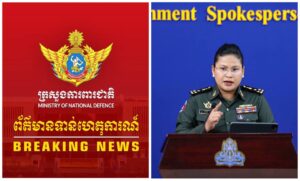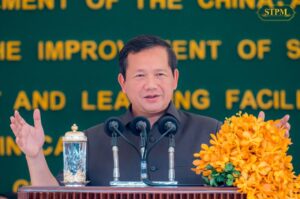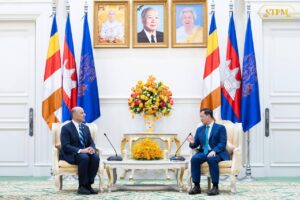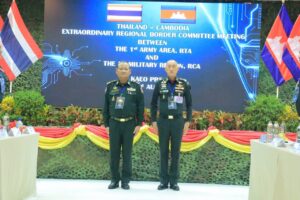Selected Comments of Samdech Thipadei Hun Manet at the official inauguration of the Phnom Chum Sen Rikreay Royal Military Police Training Center and the celebration of the 32nd anniversary of the Military Police Day [Unofficial Translation]
[1]
(1) RMPTC conducive for training for the Royal Cambodian Armed Forces, as well as bilateral or multinational exercises
In the 15 years of development, (the Phnom Chum Sen Rikreay Royal Military Police Training Center – RMPTC) has transformed into a place capable of providing training in the form of international cooperation […] This is due to the visionary efforts of HE Sao Sokha, (Deputy Commander of the RCAF and Commander of the National Military Police) as well as the Chief and the Deputy Chief of the Royal Military Police, all the Royal Military Police personnel, and those who participated in the construction with a long-term vision […] If it were not for those participations and supports, especially from Samdech Akka Moha Sena Padei Techo Hun Sen, (the former Prime Minister and current President of the Senate) with his long-term vision […] together with leaders at all levels, in all institutions, including international philanthropists, and all partners, we would have difficulty achieving achievements that are not only for the training of the Royal Military Police, but also for joint training for the Royal Cambodian Armed Forces, as well as conducive to bilateral, trilateral or multinational exercises […]
[2]
(2) To solve border issues through three positions
In resolving border disputes and efforts to clearly have proper demarcations of the border with neighboring countries, the Royal Government of Cambodia takes the following stance to – 1) maintain peace, friendship, and good cooperation with neighboring countries, including Thailand; 2) continue to cooperate with Thailand, promote the measurement and demarcation of the remaining borders between the two countries in accordance with the agreements in force, including MOU 2000 being implemented by the JBC, except for the four points (Ta Moan Thom Temple, Ta Moan Toch Temple, Ta Krabey Temple, and Mom Bei areas), which we (have brought) to the International Court of Justice for resolution; and 3) take the four areas to the International Court of Justice for resolution, because we understand that attempts to resolve them through bilateral mechanisms cannot move forward. On the contrary, it will be a long-term stalemate and face the risk of endless armed conflict […]
(3) Always ready to resolve issues through technical mechanisms, based on national and international laws and legal standards
Some friends have asked whether Cambodia has moved away from the bilateral mechanism or from resolving border disputes with neighboring countries. Please note that with Thailand, in all areas where (bilateral) solution can be reached, Cambodia has never moved away (from the bilateral mechanism), except for the four (unsettled) areas that we took to the ICJ […] We use technical mechanisms as a basis, national and international laws and legal standards to resolve the issues, avoiding the unnecessary use of armed force. However, Cambodia reserves the right and all means, including armed force, to defend itself […] Some parties ask why we are taking these four points to the (International Court of Justice) […] The Ta Moan Thom area, for example, has been an area that both sides agree that it is not yet settled, and still needs to be technically assessed […] After the fighting in 2011, both sides agreed to have both armies stationed there, allowing people from both side to visit and wait for a bilateral resolution through the JBC mechanism […]
(4) Thai political and military leaders unilaterally declared unresolved areas are in Thai territory by using a unilaterally drawn map
Recently, however, the political and military leaders (of Thailand) have unilaterally declared demanding (and) defining that the Ta Moan Thom temple is not an unresolved area, but that all of these areas are in Thai territory. While they say that they are still pending and have not been resolved, waiting to be resolved (using bilateral mechanisms), they have officially declared them (in Thai territory) using a unilateral map, and they even have been arguing with Google (which place them inside Cambodia) […] This issue, therefore, has to be brought to a third party, which is the court (ICJ) […] for once and for all resolution that is complete and accurate based on international law, even though the Thai side has declared its rejection of (the ICJ) jurisdiction […] I would like to reiterate that (the Royal Government) has decided without change that the bilateral mechanism will continue to resolve and measure the boundary, mark the border on other points, except for the four points above, we definitely proceed to the ICJ […] I hope that the Thai side does not want this problem to be chronic for generations, leading to people fighting over the temple for dozens of generations. Resolving the issue is a responsibility for national interests and history […]
(5) Immediate issues are reopening border crossings and adjusting the troops as well as weapons […]
For the immediate issue, the border crossings and military positions facing each other and ready to fight, how to solve it? […] (The solution) is to return (the border crossings that have been on and off) to the original situation. There are only two tasks to be solved. Firstly, the issue of reopening the crossings to normal again. Secondly, adjusting the troops or units, as well as the weapons […] I notice the Thai side announcing the same desire, but they seem to have put all the blames on Cambodia as the bad guy […] while in fact Cambodia wants to end the issue quickly. We do not want the people, especially those living along the border to be affected so much so that we must find a definitive solution, and not subjected to changes. We do not play the game of hiding and seeking […] The border closure was done unilaterally by the Thai side […] On June 7, Thailand closed them and changed the opening and closing times […] On June 23, it announced the closure of all crossings, closing the flow of goods and people, allowing only students, emergency patients, and a small number of jobs. Later, it reopened but did not allow (people or goods) to go in or out […] Now some crossings are open from 6 to 10 pm, but people are still not allowed […]
(6) Cambodia will follow no later than five hours should Thai reopen all border crossings unilaterally at usual times and without restrictions on goods or people
Regarding these border crossings, Cambodia is asking for three conditions. The keys are in the hands of the Thai side. There is no need to sit down and negotiate. Firstly, Thailand declares reopening them unilaterally and will not unilaterally use closing measures, while returning the border crossings to the state it was before June 7th […]; Secondly, open all border crossings at once. Thailand insists on opening this and/or that crossing as for security reason. There is no need for that. The issue of citizens doing business has nothing to do with the military. The trading at the Jam Yeam crossing has nothing to do with the military region four. Thirdly, the crossing must be opened as it was before June 7th from 6:00 am to 10:00 pm, without any restrictions on goods or people […] while these three conditions are implemented, Cambodia will follow suit in no longer than 5 hours later […] Cambodia does not want things to affect the livelihoods of the people (along the border). Cambodia wants to have a definitive solution […] and does not play hide and seek, where the border crossings are either closing or opening at will […] We do not play the game that is causing difficulties for the people living along the Cambodian-Thai border […]
(7) Thai urged to suspend all activities, especially patrols and launching drones into Cambodian territory
We must ensure the conditions for mutual trust before the negotiation (on other matters) restarts. There had been an incident before. On June 8th […] the military commanders from both sides met about adjusting troops at the Mom Bei point, in which the talk agreed that the border crossing would be reopened. However, not only that they did not open, but also the tension was even higher […] In order to work together, we must create preconditions for trust, and the easiest way is to open the border crossing as it was. This is a precondition before the military meeting […] There is propaganda in the press and the Internet as if Cambodia is the bad guy. Thailand wants to open the border, but Cambodia refuses to open it. They want to withdraw their troops, but we refuse to talk about this. It is not like that. Cambodia wants to solve the problem quickly, but solve it once and for all […]
Firstly, open the border crossings unilaterally […] When the conditions are in place, maybe after 24 hours, we will discuss meeting at some level […] Now the frontline military commanders may meet to make adjustments, but the RBC and GBC levels must wait for the implementation of the conditions for the border to open normally […] Secondly, the mobilization of forces. While the Thai army chief, the commander-in-chief, were discussing about the withdrawal of troops, the troops on the ground continued to clear the way for tanks and vehicles to enter deeper and closer to, and frequently moving patrols into the Cambodian line of defense, in addition to building trenches, pulling in support weapons and forces. Is this a will to reduce the tension and withdraw forces? I urge that they suspend all activities, especially patrols and launching drones into Cambodian territory […]
(8) Military modernization comprises of three elements – structural, human resources, and equipment and capabilities
Cambodia has confirmed and reiterated that it wants to maintain relations and stability, but reserves the right to apply all means and forms to protect Cambodia’s sovereignty and territorial integrity […] The current military confrontation, in terms of the military framework, is an opportunity for Cambodia to assess its strengths and weaknesses and set a direction to continue to promote the building of military capabilities. War kills people, but in terms of military and psychological aspects, it makes people strive to avoid war […] The confrontation from 2011 to 2025 lasts 14 years. This challenge has been an opportunity to review and set a direction for reforming the military in the future […] There was a closed meeting attended by Deputy Prime Minister and Minister of National Defense, Commander-in-Chief of the Royal Cambodian Armed Forces, Commander-in-Chief of the Army, and some military experts to review further reforms in modernizing the military […] The term “military modernization” comprises of three types of modernization – structural modernization, modernization of human resources, and modernization of equipment, equipment capabilities, […]
(9) Military structural modernization is for protecting territorial integrity against invasion attempts and not for invading anyone’s land
The structural modernization is related to the national budget. It is necessary to examine and consider increasing the national defense budget to some extent. After the war, the win-win politics, which brings peace to the country, we diverted a large amount of the national defense budget to social spending such as on human resource development, education, health and other sectors as a priority, in addition to destroying tons of weapons and ammunition […] Structural modernization must be in line with the requirements of the tasks and missions of national defense, protecting territorial integrity, against invasion attempts […] not for conquering anyone’s land […] In addition, the structure must be adjusted due to technological changes. Develop forces to adapt to technology. For example, intelligence. Previously, we had armed reconnaissance units. Now, perhaps, technical intelligence or reconnaissance using drones is required […]
(10) In peacetime, the army not only work on battlefield, but deals with non-traditional warfare problems, such as disasters
In peacetime, the army not only work on the battlefield, but also deals with non-traditional warfare problems, such as disasters, etc. […] the war that we face every day is called a war using hybrid or mixed means. Foreign language calls it hybrid warfare. We are facing this war every day. This means not using armed forces, but using information technology and systems to distort information […] How do we protect ourselves? Is there any unit that protects against electronic warfare? This is a subject that the Ministry of National Defense, the General Command, examines in terms of equipment, as well as the types of troops that we need to consider […] If there is a unit in intelligence technology and drone technology, we could train them along with those specialized in artillery, etc., and to counter hybrid warfare, and how we shall prepare to strengthen the transmission of messages? […]
(11) Military human resource is about transferring skills and knowledge to new recruits through research and modernization of training programs
Regarding building human resources […] we are talking about training. Training is necessary to transfer skills and knowledge from officers, non-commissioned officers, and experienced soldiers to new recruits/trainees. Adaptation on the battlefield is one thing, but in the peacetime period, there is a need to strengthen training, and training must strengthen the training schools and units of the army, the armed forces […] I ask the Ministry of National Defense, the commander-in-chief of the army, to review the principles of strengthening the selection of new military officers to continue training and adaptation […]
On research and modernization of training programs. Will the training center receive or should there be another research group to support the training center to connect with the schools of the Ministry of National Defense, schools under the commander-in-chief, schools of the army […] There must be an actor in charge of preparing, editing documents, drawing lesson learnt from combat experiments […] There must be consistent document management […] so that the commanders and the general staff learn one tactics and the platoon level leans differently […]
(12) RMPTC suitable for training of special military regions and/or national police to have ability to defend the country
We have been solving issues of training for equipment and materials, plus the field, […] Each unit wants to have live-fire training. There must be a limit. For example, at the provincial military level, at the brigade level, how much live-fire training there can be or need to be […] Previously, we had a lot of land, and to set up live-firing field would not be a problem. We could just pick a place and prepare for it as it was all forest areas. We only work on demining, and no one would go there. Now it is difficult to do as live-firing could hit residential areas […] (The former Prime Minister,) Samdech Techo ordered a lot of preparation in military region three. We have Chum Kiri, we have Mrah Prov. RMPTC can organize large-scale exercises or any military region can come practice without having to set up new location […] With its foresight, RMPTC was built not only for the military police, but also for special military regions, units, the national police, or any battalion level that lacks a mobile field to practice here […] As long as the country has national defense, it must be prepared. We do not go to war with anyone, but in case of a threat, we must have the ability to defend the country […] We cannot, when training sessions are done, send the troops to this/that country because there is no suitable place in the country to do it […]
(13) Conscription and pension laws will be amended to have more solders on hand
About building and maintaining the force. I have given a direction in the meeting the other day. We need to adjust the current force building method. Based on the current budget capacity, plus the management situation, I gave the principle of amending two laws. Firstly, the 2006 Military Conscription Law. It must be amended so that from 2026 onwards, the Military Conscription Law will be implemented […] I have asked to check some points to see if it is in line with the current situation. For example, the old law would call for the implementation of 18 months of military conscription […] It should be amended to 24 months to be appropriate. Most countries have 24 months conscription […]
The Military Conscription Law helps increase the number of soldiers, and the ability to recruit soldiers […] Secondly, we will amend the pension law […] By amending the conscription law and the pension law, Cambodia will have more soldiers on hand […] We will implement it in 2026, not waiting till we get to 30 years. The conscription law and the pension law have been in place for 20 years now […] As of now, the work of the soldiers is being appreciated. Some countries, they have a lottery draw. Hen someone picked a lottery that sends her/him for the military draft, s/he faints. But in Cambodia, if anyone picks a lottery that does not draft him into the army, he faints […] Our young people are eager for this opportunity […]
[3]
(14) Any tourist resort development must not overlook military training priority
Deputy Commander of the RCAF and Commander of the National Military Police, HE Sao Sokha suggested arranging a part of the Chum Sen Rikreay Mountain Military Police Training Center as natural tourism resort. Whatever we do we must not lose or affect the first priority, which is military training. We must predict the future when we have modern weapons that can shoot farther. The type of troops that come here, the field needs to maintain its usability. Do not place tourist development areas where the bullets fly through […] In the Master Plan for this RMPTC, we must anticipate that in the future, sometimes the battalion will also have armored vehicles accompanied by infantry, with 60mm, 80mm, 100 mm mortars […] They may develop it where safety is secured. Tourists come to relax and want a quiet place […]
All the army locations, whether in Mrah Prov or Chum Kiri, and/or other regional locations, we protect the land area for future use. Please protect them and avoid encroachment […] as for the navy, we may practice firing at the island. Let us be careful that unexploded waste may still be left there and cause difficulties later when the people go and build resorts […] Please consider the safety of the army and the people altogether […] About the paratroopers. Now, the military parachutists have had to do their practice at the Oral area. At Kombol, they landed on the roofs (of people’s houses). They moved from Kombol to Kdan Roy. Later, when more factories built at Kdan Roy, they moved to Oral. Just keep that location and protect it once and for all […] We cannot prevent the economy and/or the potential of tourism from growing, but we must secure land for military drill purpose as well […]./.






